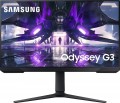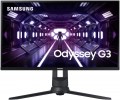Video transmission
—
VGA. A connector designed for transmitting analog video signals back in the era of CRT monitors (especially for them). Today it is considered obsolete and is gradually falling out of use - in particular, due to low bandwidth, which does not allow full work with HD content, as well as double signal conversion when using VGA in LCD monitors (which can become a potential source of interference) .
—
DVI. A connector for video signal transmission, designed specifically for LCD devices, including monitors. Although the abbreviation DVI originally stands for “digital video interface,” this interface also allows analog data transmission. Actually, there are three main types of DVI: analog, combined and digital. The first type in modern computer technology has almost gone out of use (this function is actually performed by the VGA connector), and a purely digital connector -
DVI-D - is indicated separately in our catalog (see below). Therefore, if the monitor’s specifications indicate “just DVI”, most likely we are talking about a combined DVI-I connector. In terms of the characteristics of the analog video signal, it is similar to the VGA described above (and is even compatible with it through a simple adapter); in terms of digital capabilities, it is DVI-D (single-channel, not Dual Link). However, due to the spread of purely digital standards, DVI-I is becoming less and less
...common.
— DVI-D. A variation of the DVI interface described above that supports exclusively digital video signal format. The standard (Single Link) DVI-D interface allows you to transmit video in resolutions up to 1920x1080 at a frame rate of 75 Hz or 1920x1200 at a frame rate of 60 Hz, which is already enough to work with modern resolutions up to Full HD inclusive. In addition, there is a dual-channel (Dual Link) version of this connector, which has increased bandwidth and allows you to work with resolutions up to 2560x1600 (at 60 Hz; or 2048x1536 at 75 Hz). Accordingly, the specific DVI-D type depends on the monitor resolution. In this case, a single-channel screen can be connected to a dual-channel video card, but not vice versa. Also note that the situation with connectors is similar: Single Link and Dual Link ports are slightly different in design, and a single-channel cable is compatible with dual-channel input/output, but, again, not vice versa.
— DisplayPort. An interface originally created for video transmission (however, it can also be used for audio signals - in this DisplayPort is similar to HDMI). Found in many modern monitor models. Note that monitors with DisplayPort inputs are also compatible with Thunderbolt outputs (via an adapter).
The specific capabilities of this connector depend on its version. Modern monitors have the following options:
- v.1.2. The earliest version commonly used in our time, released in 2010. It was there that features such as 3D support and the ability to connect multiple screens in a daisy chain were first introduced. Version 1.2 allows you to transmit 5K video at a frame rate of 30 fps; working with higher resolutions (up to 8K) is also possible, but with certain restrictions.
- v.1.3. DisplayPort version released in 2014. It has one and a half times more bandwidth than v.1.2, and allows you to transmit 8K video at 30 fps, 5K at 60 fps and 4K at 120 fps. In addition, this version has a Dual-mode function, which allows you to connect to HDMI and DVI outputs through simple passive adapters.
- v 1.4. In this version, the maximum frame rate when working with one screen has increased to 120 fps for the 8K standard and to 240 fps for the 4K and 5K standards (data is supposed to be transmitted with compression using DSC - Display Stream Compression technology). Other features include compatibility with HDR10 and the ability to simultaneously transmit up to 32 channels of audio.
- v2.1. 2022 version using the same physical layer specification as USB4. The interface bandwidth has been doubled compared to v 1.4 (up to 80 Gbit/s, of which 77.37 Gbit/s is available for data transfer). At the same time, it supports connecting displays with resolutions up to 16K at 60 fps, 8K at 120 fps, 4K at 240 Hz and 2K at 480 Hz (without the additional use of DSC - Display Stream Compression technology). DP40 (40 Gbps) cables can now be longer than two meters, while DP80 (80 Gbps) cables can be more than one meter long.
— Mini Display Port. A smaller version of the DisplayPort described above, used primarily in laptops; especially popular in Apple laptops. Recently, there has been a trend towards replacing the Mini Display Port with a universal Thunderbolt interface; however, this interface operates through the same connector and provides the same capabilities. In other words, monitors can be connected to Thunderbolt (versions 1 and 2) via a standard miniDisplayPort cable, without using adapters (for v3 you will still need an adapter).
— HDMI. The HDMI interface was originally designed to transmit high-definition video and multi-channel digital audio over a single cable. This is the most popular of modern interfaces for this purpose; HDMI outputs are practically mandatory both for computer video cards and for media centers, DVD/Blu-ray players and other similar equipment.
The presence of several outputs of this type in the monitor allows you to keep it connected simultaneously to several signal sources - for example, a computer and a satellite TV tuner. This way you can switch between sources through software settings without fiddling with reconnecting cables, and also use the PBP function.
At the same time, the port itself has different versions, and the most common in our time are as follows:
- - v.1.4. The earliest version actively used in our time; appeared in 2009. Supports resolutions up to 4096x2160 at 24 fps, and in the Full HD standard (1920x1080) the frame rate can reach 120 fps; 3D video transmission is also possible.
- - v.2.0. Version introduced in 2013 as a major update to the HDMI standard. Supports 4K video with frame rates up to 60 fps (due to which it is also known as HDMI UHD), as well as up to 32 channels of audio and up to 4 audio streams simultaneously. Also in this version there is support for ultra-wide format 21:9.
- - v.2.1. Quite a significant update compared to version 2.0, introduced at the end of 2017. A further increase in throughput made it possible to provide support for resolutions up to 8K at 120 fps inclusive. Improvements have also been made regarding working with HDR. Note that to use all the features of HDMI v 2.1 you need HDMI Ultra High Speed cables, although basic functions are available with regular cables.
— USB C (DisplayPort AltMode). Another type of USB interface used to work with video signals. It has a small size (not much larger than a microUSB) and a reversible design that allows you to connect the plug to either side - this makes Type C more convenient than previous standards. At the same time, we note that such a monitor may initially be designed for connection to a USB C output (at least, such an adapter cable may be supplied in the kit); it would not hurt to clarify this point separately.
— Thunderbolt interface. Thunderbolt is a data transfer protocol (used in Apple devices), the throughput of which reaches 40 Gbps. The connector itself, as well as the speed, depend on the version: Thunderbolt v1 and v2 use miniDisplayPort (see above), monitors with Thunderbolt inputs are not necessarily compatible with the original miniDisplayPort outputs - it wouldn’t hurt to check this compatibility separately. And Thunderbolt v3 is based on the USB C connector (see above).Power consumption
Rated power consumption of the monitor. Usually, this item indicates the maximum power that the device can consume during normal operation — that is, the energy consumption at maximum brightness, the highest volume of the built-in acoustics, etc. Actual power consumption can be noticeably lower, however, when choosing, it is still best to focus on the value stated in the specifications.
In general, the lower the power consumption, the more economical the device in terms of electricity consumption (ceteris paribus). In addition, this characteristic can be useful when selecting an uninterruptible power supply for a PC and in other specific situations when it is necessary to accurately determine the power consumption of equipment.
External power supply
The power supply, made separately, outside the monitor case — usually right on the power cord (similar to how it is implemented, for example, in many laptops).
This arrangement allows you to take out a fairly significant part of the hardware outside the case. Therefore,
monitors with an external power supply are themselves thinner and more elegant than similar models with a
built-in power supply. On the other hand, the need to look for a place for the PSU itself in some situations can cause inconvenience. Therefore, when choosing, it is worth considering the peculiarities of the situation: in some cases, an integrated power supply may well be the best option.

